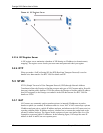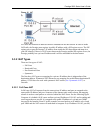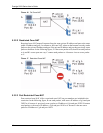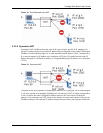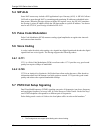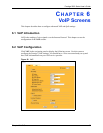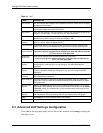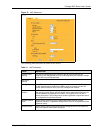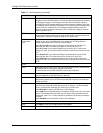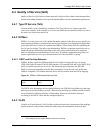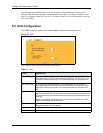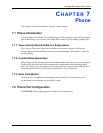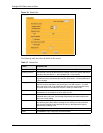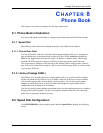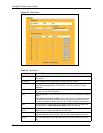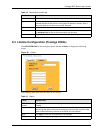
Prestige 2002 Series User’s Guide
50 Chapter 6 VoIP Screens
Min-SE When two SIP devices negotiate a SIP session, they must negotiate a common
expiration time for idle SIP sessions. This field sets the shortest expiration time that
the Prestige will accept. The Prestige checks the session expiration values of
incoming SIP INVITE requests against the minimum session expiration value that
you configure here. If the session expiration of an incoming INVITE request is less
than the value you configure here, the Prestige negotiates with the other SIP
device to increase the session expiration value to match the Prestige’s minimum
session expiration value.
RTP Port Range Real time Transport Protocol is used to handle voice data transfer. Use this field to
configure the Prestige’s listening port range for RTP traffic. Leave these fields set
to the defaults if you were not given a range of RTP ports to use.
Preferred
Compression
Type
Use this field to select the type of voice coder/decoder (codec) that you want the
Prestige to use. G.711 provides higher voice quality than G.729 but requires
64kbps of bandwidth while G.729 only requires 8kbps.
Select G.711>G.729 if you want the Prestige to first attempt to use the G.711
codec and then the G.729 codec if the peer is not set up to use G.711.
Select G.711 only if you want the Prestige to only use the G.711 codec when
making VoIP calls. You will not be able to connect to a peer that is not set up to use
G.711.
Select G.729>G.711 if you want the Prestige to first attempt to use the G.729
codec and then the G.711 codec if the peer is not set up to use G.729.
Select G.729 only if you want the Prestige to only use the G.729 codec when
making VoIP calls. You will not be able to connect to a peer that is not set up to use
G.729.
STUN
Active Select this check box to turn on STUN. Use STUN if there is a NAT router between
the Prestige and the VoIP service provider’s SIP server.
You do not need to use STUN if the NAT router is also a SIP ALG.
Server Address Your VoIP service provider must host a STUN server in order for you to use STUN.
Type the IP address of the STUN server in this field.
Server Port Enter the STUN server’s listening port for STUN requests in this field. Leave this
field set to the default if your VoIP service provider did not give you a server port
number for STUN.
DTMF Mode The Dual Tone Multi-Frequency (DTMF) mode sets how the Prestige handles the
tones that your telephone makes when you push its buttons. It is recommended
that you use the same mode that your VoIP service provider uses.
Select RFC 2833 to send the DTMF tones in RTP packets.
Select PCM (Pulse Code Modulation) to include the DTMF tones in the voice data
stream. This method works best when you are using a codec that does not use
compression (like G.711). Codecs that use compression (like G.729) could distort
the tones.
Select SIP INFO to send the DTMF tones in SIP messages.
Back Click Back to return to the VoIP screen without saving configuration changes.
Apply Click Apply to save your changes back to the Prestige.
Reset Click Reset to begin configuring this screen afresh.
Table 11 VoIP Advanced (continued)
LABEL DESCRIPTION



